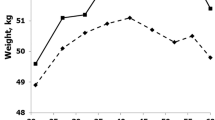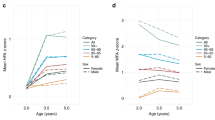Abstract
Background/objectives
Information on recent changes in overweight, obesity, and adiposity among American Indians is scarce. To assess changes in size and adiposity among American Indian youth, data from two samples of Akwesasne Mohawk youth, were compared.
Subjects/methods
Both project 1, conducted in 1979 (n = 75) and Project 2, conducted between 1996 and 1999 (n = 206), sampled youth 10–14 years of age from the Akwesasne Mohawk Reservation (aka St. Regis) that borders New York state, and Ontario and Quebec provinces. Heights, weights, and skinfold thicknesses were converted to z-scores using CDC reference values. BMI status was calculated in terms of WHO age-specific cutoffs and CDC cutoffs.
Results
z-Scores for heights differed little between projects. The between-project difference in weight z-score is twice the between-project z-score difference for height. Differences among males are larger and more often significant. Triceps and subscapular skinfold thickness are significantly greater in Project 2. The rate of overweight and obesity combined, increased 3.3-fold. In multiple regression analyses with sex, height, and age in the model, project is a significant predictor of weight and skinfolds.
Conclusions
Weight and adiposity have increased substantially from 1979 to 1996–99. Overweight and obesity became significantly more common. Given the increase in adiposity, these youth may be facing significant health risks as adults in terms of cardiovascular disease, cancer, and type II diabetes unless weight and adiposity is reduced.
This is a preview of subscription content, access via your institution
Access options
Subscribe to this journal
Receive 12 print issues and online access
$259.00 per year
only $21.58 per issue
Buy this article
- Purchase on Springer Link
- Instant access to full article PDF
Prices may be subject to local taxes which are calculated during checkout

Similar content being viewed by others
References
Fryar CD, Gu Q, Ogden CL, Flegal KM. Anthropometric reference data for children and adults: United States, 2011–2014. Vital Health Stat. 2016;3:1–46.
Hales CM, Carroll MD, Fryar CD, Ogden CL. Prevalence of obesity among adults and youth: United States, 2015–2016. NCHS data brief, no 288. Hyattsville, MD: National Center for Health Statistics. 2017.
National Center for Health Statistics, Health, United States, 2016. With chartbook on long-term trends in health. Hyattsville, MD: National Center for Health Statistics; 2017.
Broussard BA, Johnson A, Himes JH, Story M, Fichtner R, Hauck F, et al. Prevalence of obesity in American Indians and Alaska Natives. Am J Clin Nutr. 1991;53(Suppl. 6):1535S–1542S.
Byers T. The epidemic of obesity in American Indians. Am J Dis Children. 1992;146:285–6.
Conway JM. Ethnicity and energy stores. Am J Clin Nutr. 1995;62(Suppl. 5):1067S–1071S.
Gallo MV, Schell LM. Height, weight, and body mass index among Akwesasne Mohawk youth. Am J Hum Biol. 2005;17:269–79.
Gallo MV, Schell LM. Selected anthropometric measurements of Akwesasne Mohawk youth: skinfolds, circumferences, and breadths. Am J Hum Biol. 2007;19:525–36.
Subica AM, Agarwal N, Sullivan JG, Link BG. Obesity and associated health disparities among understudied multiracial, Pacific Islander, and American Indian adults. Obesity. 2017;25:2128–36.
Styne DM. Childhood obesity in American Indians. J Publ Health Manag Pract. 2010;16:381–7.
Vijayakumar P, Wheelock KM, Kobes S, Nelson RG, Hanson RL, Knowler WC, et al. Secular changes in physical growth and obesity among southwestern American Indian children over four decades. Pediatr Obes. 2018;13:94–102.
Bullock A, Sheff K, Moore K, Manson S. Obesity and overweight in American Indian and Alaska Native children, 2006–2015. Am J Public Health. 2017;107:1502–7.
Schell LM, Gallo MV, Johnston FE. Growth and development. In: Ubelaker D, editor. Handbook of North American Indians: environment, origins, and population. Smithsonian Institution: Washington, DC; 2006 727–39.
Schell LM, Gallo MV. Overweight and obesity among North American Indian infants, children, and youth. Am J Hum Biol. 2012;24:302–13.
Akwesasne Task. Force on the environment, superfund clean-up at Akwesasne: a case study in environmental justice. Int J Contemp Sociol. 1997;34:267–90.
Fitzgerald EF, Hwang SA, Brix KA, Bush B, Cook K, Worswick P. Fish PCB concentrations and consumption patterns among Mohawk women at Akwesasne. J Expo Anal Environ Epidemiol. 1995;5:1–19.
Fitzgerald EF, Hwang SA, Bush B, Cook K, Worswick P. Fish consumption and breast milk PCB concentrations among Mohawk women at Akwesasne. Am J Epidemiol. 1998;148:164–72.
George-Kanentiio D. Iroquois population in 1995. Akwesasne Notes. 1995;1:61.
Goran MI, Kaskoun M, Johnson R, Martinez C, Kelly B, Hood V. Energy expenditure and body fat distribution in Mohawk children. Pediatrics. 1995;95:89–95.
Krook L, Maylin GA, Lillie JH, Wallace RS. Dental fluorosis in cattle. Cornell Vet. 1983;73:340–62.
Labreche J. An island unfit for man or beast. Macleans Magazine. 1979 (July 30). p. 40-41.
Pfeiffer S, Dibblee L. The effect of urbanization on the growth of Canadian Native children. Can J Anthropol 1982;2:217–24.
Cameron N. The methods of auxological anthropometry. In: Treatise TJ, Falkner F, editors. Human growth: a comprehensive. New York: Plenum; 1978. p. 35–90.
Schell LM, Hubicki LA, DeCaprio AP, Gallo MV, Ravenscroft J, Tarbell A, et al. Organochlorines, lead, and mercury in Akwesasne Mohawk youth. Environ Health Perspect. 2003;111:954–61.
Lohman TG, Roche AF, Martorell R. Anthropometric standardization reference manual. Champaign, IL: Human Kinetics Books; 1988.
McDowell MA, Fryar CD, Hirsch R, Ogden CL. Anthropometric reference data for children and adults: U.S. population, 1999–2002. Hyattsville, MD: National Center for Health Statistics; 2005. p. 1–31.
Kuczmarski RJ, Ogden CL, Guo SS, Grummer-Strawn LM, Flegal KM, Mei Z, et al. 2000 CDC growth charts for the United States: methods and development. Vital Health Stat. 2002;11:1–190.
Ogden CL, Fryar CD, Carroll MD, Flegal KM. Mean body weight, height, and body mass index, United States 1960–2002. Advance Data from Vital and Health statistics, 2004. Hyattsville, Maryland: National Center for Health Statistics. 347:1–17.
Brewis AA. Obesity: cultural and biocultural perspectives. Studies in medical anthropology. New Brunswick, NY: Rutgers University Press; 2011. p. 209.
Schell LM, Gallo MV, Horton HD. Power and pollutant exposure in the context of American Indian health and survival. Ann Hum Biol. 2016;43:107–14.
Campbell JM, Lane M, Owens JA, Bakos HW. Paternal obesity negatively affects male fertility and assisted reproduction outcomes: a systematic review and meta-analysis. Reprod Biomed Online. 2015;31:593–604.
Moslehi N, Shab-Bidar S, Ramezani Tehrani F, Mirmiran P, Azizi F. Is ovarian reserve associated with body mass index and obesity in reproductive aged women? A meta-analysis. Menopause. 2018;25:1046–55.
Silvestris E, Pergola Gde, Rosania R, Loverro G. Obesity as disruptor of the female fertility. Reprod Biol Endocrinol. 2018;16:22.
Gallo MV, Ravenscroft J, Carpenter DO, Frye C, Akwesasne Task Force on the Environment, Cook B, et al. Endocrine disrupting chemicals and ovulation: Is there a relationship?. Environ Res. 2016;151:410–8.
Hoover E. The River is in US. Minneapolis: Univeristy of Minnesota Press; 2017.
Hoover E. Cultural and health implications of fish advisories in a Native American community. Ecol Process. 2013;2:1–20.
Schell LM, Gallo MV, Cook K. What’s NOT to eat—food adulteration in the context of human biology. Am J Hum Biol. 2012;24:139–48.
Newbold RR, Padilla-Banks E, Jefferson WN, Heindel JJ. Effects of endocrine disruptors on obesity. Int J Androl. 2008;31:201–8.
Newbold RR, Padilla-Banks E, Snyder RJ, Phillips TM, Jefferson WN. Developmental exposure to endocrine disruptors and the obesity epidemic. Reprod Toxicol. 2007;23:290–6.
Elobeid MA, Padilla MA, Brock DW, Ruden DM, Allison DB. Endocrine disruptors and obesity: an examination of selected persistent organic pollutants in the NHANES 1999–2002 data. Int J Environ Res Publ Health. 2010;7:2988–3005.
Heindel JJ. Endocrine disruptors and the obesity epidemic. Toxicol Sci. 2003;76:247–9.
Hertz-Picciotto I, Charles MJ, James RA, Keller JA, Willman E, Teplin S. In utero polychlorinated biphenyl exposures in relation to fetal and early childhood growth. Epidemiology. 2005;16:648–56.
Verhulst SL, Nelen V, Hond ED, Koppen G, Beunckens C, Vael C, et al. Intrauterine exposure to environmental pollutants and body mass index during the first 3 years of life. Environ Health Perspect. 2009;117:122–6.
Lee DH, Steffes MW, Sjodin A, Jones RS, Needham LL, Jacobs DR Jr. Low dose organochlorine pesticides and polychlorinated biphenyls predict obesity, dyslipidemia, and insulin resistance among people free of diabetes. PLoS ONE. 2011;6:e15977.
Schell LM, Gallo MV, Deane GD, Nelder KR, DeCaprio AP, Jacobs A, and Akwesasne Task Force on the Envrionemnt. Relationships of polychlorinated biphenyls and dichlorodiphenyldichloroethylene (p,p’-DDE) with testosterone levels in adolescent males. Environ Health Perspect. 2014;122:304–9.
Schell LM, Burnitz KK, Gallo MV. Growth as a mirror: is endocrine disruption challenging Tanner’s concept?. Ann Hum Biol. 2012;39:361–71.
Ravenscroft J, Schell LM, Akwesasne Task Force on the Environment. Patterns of PCB exposure among Akwesasne adolescents: the role of dietary and inhalation pathways. Environ Int. 2018;121:963–72.
Sotero M. A conceptual model of historical trauma: implications for public health practice and research. J Health Dispar Res Practice. 2006;1:93–108. Available at SSRN: https://ssrn.com/abstract=1350062.
Walters K, Mohammed S, Evans-Campbell T, Beltrán R, Chae D, Duran B. (2011). BODIES DON’T JUST TELL STORIES, THEY TELL HISTORIES: embodiment of historical trauma among American Indians and Alaska Natives. Du Bois Rev. 2011;8:179–89. https://doi.org/10.1017/S1742058X1100018X
Bombay A, Matheson K, Anisman H. The intergenerational effects of Indian residential schools: implications for the concept of historical trauma. Transcult Psychiatry. 2014;51:320–38. https://doi.org/10.1177/1363461513503380
Akerstedt T. Psychosocial stress and impaired sleep. Scand J Work Environ Health. 2006;32:493–501.
Liu Y, Wheaton AG, Chapman DP, Cunningham TJ, Lu H, Croft JB. Prevalence of healthy sleep duration among adults—United States, 2014. Morb Mortal Wkly Rep. 2016;65:137–41.
Marley TL, Metzger MW. A longitudinal study of structural risk factors for obesity and diabetes among American Indian young adults, 1994–2008. Prevent Chronic Dis. 2015;12:1–10. https://doi.org/10.5888/pcd12.140469
Acknowledgements
The authors thank the gracious people of the Akwesasne Mohawk Nation for their collaboration in the projects. Financial support for this research was provided by the National Institute on Minority Health and Health Disparities (#MD003373) and the National Institute of Environmental Health Sciences (#ES04913).
Author information
Authors and Affiliations
Consortia
Corresponding author
Ethics declarations
Conflict of interest
The authors declare that they have no conflict of interest.
Additional information
Publisher’s note: Springer Nature remains neutral with regard to jurisdictional claims in published maps and institutional affiliations.
Rights and permissions
About this article
Cite this article
Schell, L.M., Gallo, M.V., Pfeiffer, S. et al. Trends in height, weight, BMI, skinfolds, and measures of overweight and obesity from 1979 through 1999 among American Indian Youth: The Akwesasne Mohawk. Int J Obes 44, 656–663 (2020). https://doi.org/10.1038/s41366-019-0349-5
Received:
Revised:
Accepted:
Published:
Issue Date:
DOI: https://doi.org/10.1038/s41366-019-0349-5
This article is cited by
-
Risk Factors in Adolescence for the Development of Elevated Blood Pressure and Hypertension in American Indian and Alaskan Native Adults
Journal of Immigrant and Minority Health (2021)



